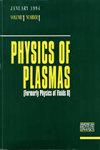Modeling of nonequilibrium effects in a compressible plasma based on the lattice Boltzmann method
IF 2.2
3区 物理与天体物理
Q3 PHYSICS, FLUIDS & PLASMAS
引用次数: 0
Abstract
A magnetohydrodynamic lattice Boltzmann method (MHD-LBM) model for a 2D compressible plasma based on the finite volume scheme is established. The double distribution D2Q17 discrete velocities are used to simulate the fluid field. The hyperbolic Maxwell equations, which satisfy the elliptic constraints of Maxwell's equations and the constraint of charge conservation, are used to simulate the electromagnetic field. The flow field and electromagnetic field are coupled to simulate a compressible plasma through the electromagnetic force and magnetic induction equations. Four typical cases, the Taylor vortex flow, strong blast, Orszag–Tang vortex, and one-dimensional Riemann problems, are simulated to validate the MHD-LBM model for a compressible plasma. It is found that shock waves widely exist in a compressible plasma, and strong nonequilibrium effects exist around each shock wave. The quantitative simulation for the Brio–Wu problem demonstrates that this model can easily obtain the physical characteristics of nonequilibrium effects at sharp interfaces (shock waves and detonation waves). The magnetic fields can affect the magnitudes to which the system deviates from its equilibrium state. The viscosity can increase the magnitudes to which the system deviates from its equilibrium state. Compared with existing compressible MHD, these results for nonequilibrium effects can provide mesoscopic physical insights into the flow mechanism of a shock wave in a supersonic plasma.基于晶格玻尔兹曼法的可压缩等离子体非平衡效应建模
建立了基于有限体积方案的二维可压缩等离子体的磁流体力学晶格玻尔兹曼法(MHD-LBM)模型。采用双分布 D2Q17 离散速度模拟流体场。双曲麦克斯韦方程满足麦克斯韦方程的椭圆约束和电荷守恒约束,用于模拟电磁场。流场和电磁场通过电磁力方程和磁感应方程耦合模拟可压缩等离子体。模拟了泰勒涡流、强冲击波、Orszag-Tang 涡流和一维黎曼问题等四种典型情况,以验证可压缩等离子体的 MHD-LBM 模型。结果发现,可压缩等离子体中广泛存在冲击波,每个冲击波周围都存在强烈的非平衡效应。对 Brio-Wu 问题的定量模拟表明,该模型可以轻松获得尖锐界面(冲击波和爆轰波)处非平衡效应的物理特征。磁场会影响系统偏离平衡状态的幅度。粘度会增加系统偏离平衡状态的幅度。与现有的可压缩 MHD 相比,这些非平衡效应的结果可以为超音速等离子体中冲击波的流动机制提供介观物理见解。
本文章由计算机程序翻译,如有差异,请以英文原文为准。
求助全文
约1分钟内获得全文
求助全文
来源期刊

Physics of Plasmas
物理-物理:流体与等离子体
CiteScore
4.10
自引率
22.70%
发文量
653
审稿时长
2.5 months
期刊介绍:
Physics of Plasmas (PoP), published by AIP Publishing in cooperation with the APS Division of Plasma Physics, is committed to the publication of original research in all areas of experimental and theoretical plasma physics. PoP publishes comprehensive and in-depth review manuscripts covering important areas of study and Special Topics highlighting new and cutting-edge developments in plasma physics. Every year a special issue publishes the invited and review papers from the most recent meeting of the APS Division of Plasma Physics. PoP covers a broad range of important research in this dynamic field, including:
-Basic plasma phenomena, waves, instabilities
-Nonlinear phenomena, turbulence, transport
-Magnetically confined plasmas, heating, confinement
-Inertially confined plasmas, high-energy density plasma science, warm dense matter
-Ionospheric, solar-system, and astrophysical plasmas
-Lasers, particle beams, accelerators, radiation generation
-Radiation emission, absorption, and transport
-Low-temperature plasmas, plasma applications, plasma sources, sheaths
-Dusty plasmas
 求助内容:
求助内容: 应助结果提醒方式:
应助结果提醒方式:


